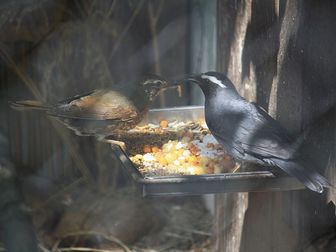Siberian Thrush
It breeds in taiga in Siberia. It is strongly migratory, with most birds moving to southeastern Asia during the winter. It is a very rare vagrant to western Europe. It is very secretive.

Original source: Matěj BaťhaPermission(Reusing this file) This file is licensed under the Creative Commons Attribution-Share Alike 3.0 Unported license.You are free:to share – to copy, distribute and transmit the work
Author: Matěj BaťhaPermission(Reusing this file) This file is licensed under the Creative Commons Attribution-Share Alike 3.0 Unported license.You are free:to share – to copy, distribute and transmit the work
The Siberian Thrush is classified as Least Concern. Does not qualify for a more at risk category. Widespread and abundant taxa are included in this category.
The Siberian Thrush, Zoothera sibirica, is a member of the Thrush family Turdidae. It breeds in taiga in Siberia. It is strongly migratory, with most birds moving to southeastern Asia during the winter. It is a very rare vagrant to western Europe. It is very secretive. The Siberian Thrush is similar in size to the Song Thrush. It is omnivorous, eating a wide range of insects, earthworms and berries. More
A superb first-winter SIBERIAN THRUSH was discovered today at Glandford, just 2 miles SW of Cley (Norfolk), where it flew in to a wire fence at the Natural Surroundings NR just east of the minor road between Letheringsett and Blakeney. Paul Laurie picked the bird up which had become very wet and bedraggled and rehabilitated it in a large Red Squirrel cage, which was positioned in front of the reserve shop. More
First-winter male Siberian Thrush in captivity, Natural Surroundings NR, Glandford, Norfolk, 3 March 2009 (John Miller) I am afraid that after spending the best part of a week investigating this claim and to talking to the cage bird trade, the finder and those with a vested interest in the bird, birders with experience of the species in the wild in Asia in spring and to ringers, the first-winter male Siberian Thrush recorded last week at Glandford is being accepted on to Category D1. More
The Siberian Thrush is similar in size to the Song Thrush. It is omnivorous, eating a wide range of insects, earthworms and berries. The male Siberian Thrush is a dark blue-grey above and below, with a white stripe above the eye. The lower belly and flanks are white. The female is a much browner bird, with a buff stripe above the eye. More
Siberian Thrush determination Similar species Turdidae American Robin | Blackbird | Black-Throated Thrush | Dusky Thrush | Eyebrowed Thrush | Fieldfare | Grey-cheeked Thrush | Hermit Thrush | Mistle Thrush | Naumanns Thrush | Red-Throated Thrush | Redwing | Ring Ouzel | Rock Thrush | Siberian Thrush | Song Thrush | Swainsons Thrush | More
For the purposes of our bird news services, Siberian Thrush is classed as Mega: species which have not yet occurred in the British Isles or are exceedingly rare, or are otherwise highly desirable. More
Front view of a Siberian Thrush perching on a decaying tree stump. The head is in profile showing a streak of white feathers. More
Siberian Thrush, Shetland, Fair Isle 25/09/08 © Dougie Preston All these good birds, and it ain't even October yet! Send this as a postcard Siberian Thrush - Siberian Thrush, Shetland, Fair Isle 25 September 2008 © Andrew Jordan Sorry for late posting! Siberian Thrush - Siberian Thrush, Norfolk, Glandford 4th March 2009 © Simon Chidwick Photo taken whilst bird in captivity this afternoon Siberian Thrush More
Family : Turdidae
Genus : Zoothera
Species : sibirica
Authority : (Pallas, 1776)
